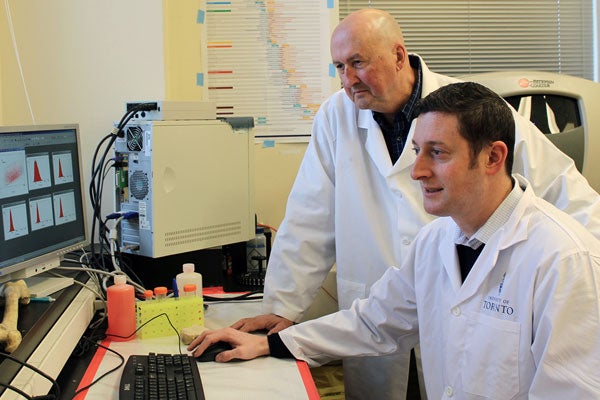
A potential breakthrough in the treatment of osteoporosis
Published: March 21, 2016
Imagine telling patients suffering from age-related (type-II) osteoporosis that a single injection of stem cells could restore their normal bone structure.
Researchers from the University of Toronto and the Ottawa Hospital suggest that this scenario may not be too far away.
Read the study in Stem Cells Translational Medicine
Osteoporosis affects more than 200 million people worldwide. Unlike post-menopausal (Type I) osteoporosis, both women and men are equally susceptible to developing the age-related (Type II) form of this chronic disease.
Age-related osteoporosis affects the inner structure of the bone, leaving it thinner, less dense, with loss of function. The disease is responsible for an estimated 8.9 million fractures per year worldwide.
Fractures of the hip, one of the most common breaks among those suffering from Type II osteoporosis, lead to a significant lack of mobility. For some these fractures are deadly.
But how can an injection of stem cells reverse the ravages of age in the bones?
Professor William Stanford, senior author of the study, had previously demonstrated a causal effect between mice that developed age-related osteoporosis and low or defective mesenchymal stem cells (MSCs) in these animals.
“We reasoned that if defective MSCs are responsible for osteoporosis, transplantation of healthy MSCs should be able to prevent or treat osteoporosis,” said Stanford, who is a senior scientist at the Ottawa Hospital and professor at the University of Ottawa.
To test that theory, the researchers injected osteoporotic mice with MSCs from healthy mice. Stem cells are “progenitor” cells, capable of dividing and changing into all the different cell types in the body. Able to become bone cells, MSCs have a second unique feature, ideal for the development of human therapies: these stem cells can be transplanted from one person to another without the need for matching (an essential requirement for blood transfusions, for instance) and without being rejected.
Six months after the injection – a quarter of the life span of these animals – the osteoporotic bone had astonishingly given way to healthy, functional bone.
“We had hoped for a general increase in bone health,” said Professor John E. Davies of the University of Toronto's Faculty of Dentistry and the Institute of Biomaterials & Biomedical Engineering (IBBME), co-author of the study.
“But the huge surprise was to find that the exquisite inner ‘coral-like’ architecture of the bone structure of the injected animals, which is severely compromised in osteoporosis, was restored to normal.”
The study could soon give rise to a whole new paradigm for treating or even indefinitely postponing the onset of osteoporosis. Currently there is only one commercially available therapy for type-II osteoporosis, a drug that maintains its effectiveness for just two years.
While there are no human stem cell trials looking at a systemic treatment for osteoporosis, the long-range results of this study point to the possibility that as little as one dose of stem cells might offer long-term relief.
“It’s very exciting,” said U of T alumnus Dr. Jeff Kiernan, first author of the study. A graduate from IBBME who is beginning a postdoctoral fellowship at the Ottawa Hospital Research Institute with the Centre for Transfusion Research, Kiernan pursued the research as part of his doctoral degree.
“We’re conducting ancillary trials with a research group in the United States, where elderly patients have been injected with MSCs to study various outcomes. We’ll be able to look at those blood samples for biological markers of bone growth and bone reabsorption,” he added.
If improvements to bone health are observed in these ancillary trials, according to Stanford, larger dedicated trials could follow within the next five years.
Stem cells were first discovered in the early 1960s by University of Toronto professors James E. Till and Ernest McCulloch. U of T remains a world leader in stem cell research.
Read more about stem cell research at U of T
Erin Vollick is a writer with the Faculty of Dentistry at the University of Toronto



